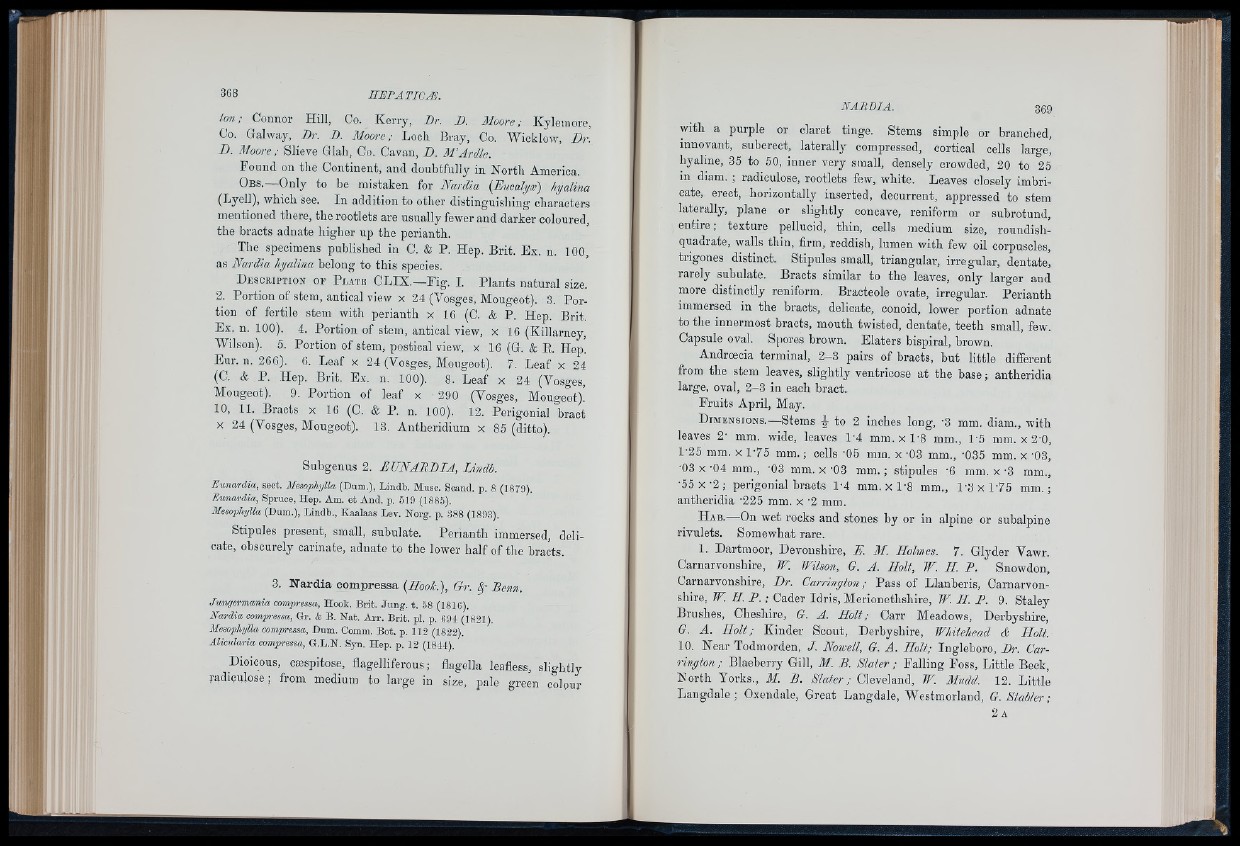
ton; Connor Hill, Co. Kerry, Br. B. Moore; Kylemore,
Co. Galwiij', Br. B. Moore; Loch Bray, Co. Wicklow, Br.
B . Moore ; Slieve Glah, Co. Cavan, B . MArdle.
Found on the Continent, and doubtfully in North America.
O b s .— Only to be mistaken for Nardia [Eucalyx) hyalina
(Lyell), which see. In addition to other distinguishing charaoters
mentioned there, the rootlets are usually fewer and darker coloured,
the bracts adnate higher up the perianth.
The specimens published in C. & P. Hep. Brit. Ex. n. 100,
as Nardia hyalina belong to this species.
D escription or P late CLIX.—Fig. I. Plants natural size.
2. Portion of stem, antioal view x 24 (Vosges, Mougeot). 3. Portion
of fertile stem with perianth x 16 (C. & P. Hep. Brit.
Ex. n. 100). 4. Portion of stem, antical view, x 16 (Killarney,
Wilson). 5. Portion of stem, postieal view, x 16 (G. & E. Hep!
Eur. n. 266). 6. Leaf x 24 (Vosges, Mougeot). T. Leaf x 24
(C. & P. Hep. Brit. Ex. n. 100). 8. Leaf x 24 (Vosges,
Mougeot). 9. Portion of leaf x 290 (Vosges, Mougeot)!
10, 11. Bracts x 16 (C. & P. n. 100). 12. Perigonia] bract
X 24 (Vosges, Mougeot). 13. Antheridium x 85 (ditto).
Subgenus 2. EUNABBIA, Lindb.
Eimardia, sect. Mesophylla (Dum.), Lindb. Muse. Scand. p. 8 (1879).
Eunardia, Spruce, Hep. Am. et And. p. 519 (1885).
Mesophylla (Dum.), Lindb., Kaalaas Lev. Norg. p. 388 (189S).
Stipules present, small, subulate. Perianth immersed, delicate,
obscurely carinate, adnate to the lower half of the bracts.
3. Nardia compressa [Hook.), Gr. fl Benn.
Jungermania compressa. Hook. Brit. Ju n g . t. 58 (1816).
Nardia comp-essa, Gr. & B. Nat. A rr. Brit. pi. p. 694 (1821).
Mesophylla comp-essa, Dum. Comm. Bot. p. 112 (1822).
Alicularia comp-essa, G.L.N. Syn. Hep. p. 12 (1844).
Dioicous, cæspitose, flagelliferous; flagella leafless, slightly
radiculose; from medium to large in size, pale green colour
with a purple or claret tinge. Stems simple or branched,
innovant, suberect, laterally compressed, cortical cells large,
hyaline, 35 to 50, inner very small, densely crowded, 20 to 25
in diam. ; radiculose, rootlets few, white. Leaves closely imbricate,
erect, horizontally inserted, decurrent, appressed to stem
laterally, plane or slightly concave, reniform or suhrotund,
entire ; texture pellucid, thin, cells medium size, roundish-
quadrate, walls thin. Arm, reddish, lumen with few oil corpuscles,
trigones distinct. Stipules small, triangular, irregular, dentate,
rarely subulate. Bracts similar to the leaves, only larger and
more distinctly reniform. Bracteole ovate, irregular. Perianth
immersed in the bracts, delicate, conoid, lower portion adnate
to the innermost bracts, mouth twisted, dentate, teeth small, few.
Capsule oval. Spores brown. Elaters bispiral, brown.
Androecia terminal, 2-3 pairs of bracts, but little different
from the stem leaves, slightly ventricose at the base ; antheridia
large, oval, 2-3 in each bract.
Fruits April, May.
D imensions.—Stems -J- to 2 inches long, '3 mm. diam., with
leaves 2' mm. wide, leaves IT mm. x lA mm., 1'5 mm. x 2’0,
1-25 mm. x 175 mm. ; cells -05 mm. x -03 mm., '035 mm. x '03,
'03 X '04 mm., '03 mm. x '03 mm. ; stipules ’6 mm. x A mm.,
•55 X-2; perigonial bracts 1-4 mm. x 1-8 mm., 1-3 x 1-75 mm.;
antheridia -225 mm. x ’2 mm.
Hab. On wet rocks and stones by or in alpine or subalpine
rivulets. Somewhat rare.
1. Dartmoor, Devonshire, E. M. Holmes. 7. Glyder Vawr.
Carnarvonshire, W. Wilson, G. A. Holt, W. II. P. Snowdon,
Carnarvonshire, Br. Carrinyton ; Pass of Llanberis, Carnarvonshire,
W. H. P. ; Cader Idris, Merionethshire, W. II. P. 9. Staley
Brushes, Cheshire, G. A. Holt; Carr Meadows, Derbyshire,
G. A. Holt; Kinder Scout, Derbyshire, Whitehead ê Holt.
10. Near Todmorden, J. Nowell, G. A. Holt; Ingleboro, Br. Carrington;
Blaeberry Gill, M. B. Staler ; Falling Foss, Little Beck,
North Yorks., M. B. Slater ; Cleveland, W. Aludd. 12. Little
Langdale; Oxendale, Great Langdale, Westmorland, G. Stabler;
2 a